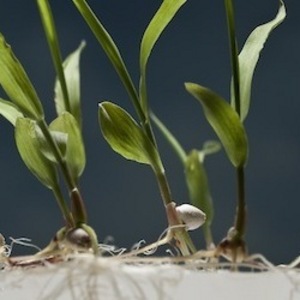Chromatin announces production of farnesene in sorghum




Chromatin Inc.
February 25, 2014
BY Chromatin Inc.
Chromatin Inc., an agriculture technology company, has announced that it has created sorghum plants containing elevated levels of the energy-rich compound farnesene.
“We have demonstrated that sorghum can be modified to produce significantly elevated quantities of farnesene relative to commercial inbred sorghum lines, a molecule that can be used to create energy-rich biofuel,” said Ken Davenport, chief technology officer of Chromatin. “To achieve this result, we added and expressed up to nine genes, creating an entire biosynthetic pathway in sorghum. Chromatin’s unique expertise in gene stacking has enabled us to combine more genes than previously reported in this crop.”
Advertisement
This milestone achievement was supported in part by the Department of Energy’s ARPA-E program Plants Engineered To Replace Oil (PETRO). Chromatin’s scientific team, led by Ramesh Nair, presented the work Feb. 25 at the 2014 ARPA-E Energy Innovation Summit.
Like sugarcane, sorghum has traditionally been used as a source of sugars that can be subsequently converted to biofuels by microbes. By creating farnesene within sorghum, it becomes possible to bypass expensive microbial fermentation and directly harvest biofuels from the crop itself. Because sorghum can grow on over 80 percent of the world’s land, including marginal land with limited access to water, this innovation could lead to a global expansion of on-farm biofuel production. “With this demonstration, we can focus on making changes that increase the quantities of farnesene made within this crop, as well as in the related crop sugarcane,” said Davenport. “Further, because farnesene is part of the terpenoid pathway, we can now consider using sorghum and sugarcane to create other high-value chemicals, including fragrances, flavors, and fuels.”
Chromatin is bringing innovations to sorghum — a high-yielding and drought tolerant crop that can meet the growing demand for sustainable biomass production. Chromatin’s product pipeline includes sorghum hybrids for traditional agriculture, as well as biomass and sugar-rich hybrids designed for renewable energy applications.
Advertisement
“We are pleased to include farnesene sorghum as part of our product pipeline,” said Daphne Preuss, Chromatin’s CEO. “Although several years of development are required before a product launch, Chromatin’s work shows that sorghum can be developed as a biorefinery, capable of sustainable production of complex chemicals.”
Related Stories
The U.S. Department of Energy Bioenergy Technologies Office (BETO) announced up to $23 million in funding to support research and development (R&D) of domestic chemicals and fuels from biomass and waste resources.
The U.S. DOE has announced its intent to issue funding to support high-impact research and development (R&D) projects in two priority areas: sustainable propane and renewable chemicals and algal system cultivation and preprocessing.
Sens. Sherrod Brown, D-Ohio, and Pete Ricketts, R-Neb., in August introduced the Renewable Chemicals Act, a bill that aims to create a tax credit to support the production of biobased chemicals.
The Chemical Catalysis for Bioenergy Consortium, a consortium of the U.S. DOE’s Bioenergy Technologies Office, has launched an effort that aims to gather community input on the development of new biomass processing facilities.
USDA on March 8 celebrated the second annual National Biobased Products Day, a celebration to raise public awareness of biobased products, their benefits and their contributions to the U.S. economy and rural communities.
Upcoming Events










